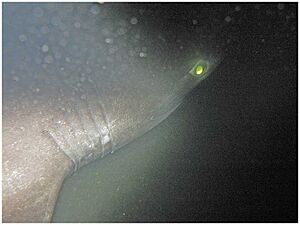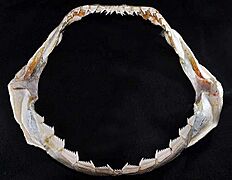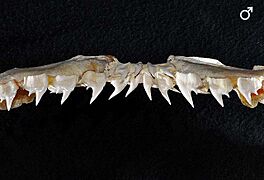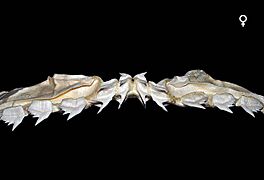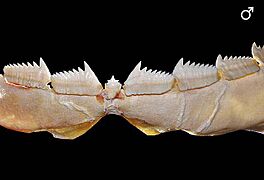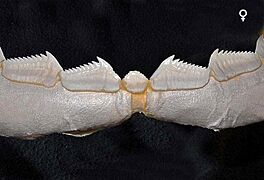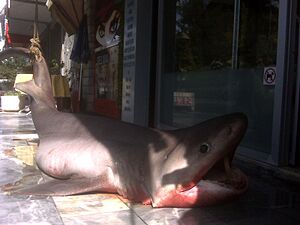Bluntnose sixgill shark facts for kids
Quick facts for kids Bluntnose sixgill shark |
|
|---|---|
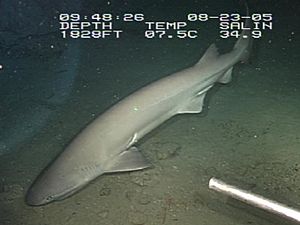 |
|
| Conservation status | |
| Scientific classification | |
| Genus: |
Hexanchus
|
| Species: |
griseus
|
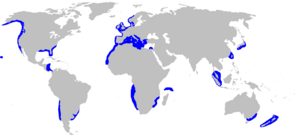 |
|
| Range of bluntnose sixgill shark (in blue) | |
The bluntnose sixgill shark is a fascinating deep-sea creature. It's also known as the cow shark. This shark is the biggest of its kind, growing up to 20 ft (6.1 m) long! You can find it in warm and cool waters all over the world. It eats many different things depending on where it lives.
The bluntnose sixgill is part of a group called Hexanchus. There are two other types of sixgill sharks: the bigeye sixgill shark and the Atlantic sixgill shark. Scientists can tell these three species apart by looking at their genes.
Contents
- Discovering the Bluntnose Sixgill Shark
- What Does a Sixgill Shark Look Like?
- How Sixgill Sharks Grow and Develop
- Where Sixgill Sharks Live
- Daily Deep-Sea Journeys
- How Sixgill Sharks Hunt
- Life and Habits of the Sixgill Shark
- Sixgill Shark Babies
- Sixgill Sharks and Humans
- Cool Discoveries About Sixgill Sharks
Discovering the Bluntnose Sixgill Shark
The bluntnose sixgill shark was first described by a scientist named Pierre Joseph Bonnaterre in 1788. This means he was the first to give it a scientific name. This shark belongs to a group called Hexanchidae. It has more ancient relatives found as fossils than living ones today.
Some of its living relatives include dogfish, the Greenland shark, and other sharks with six or seven gills. Some of these shark relatives lived as far back as 200 million years ago! The bluntnose sixgill shark is special because it has both very old and modern features.
What Does a Sixgill Shark Look Like?
The bluntnose sixgill shark has a large body and a long tail. Its snout is wide and blunt, and its eyes are quite small. It has six rows of saw-like teeth on its lower jaw. The teeth on its upper jaw are smaller.
Its skin can be tan, brown, or even black. It has a light line along its sides and on the edges of its fins. You might also see darker spots on its sides. As they get older, they get more spots. Their eyes have black pupils and a cool blue-green color.
This shark can grow up to 5.5 m (18 ft) (about 18 feet) long. Some very large ones can reach 6 m (20 ft) (20 feet) and weigh 1,000 kg (2,200 lb) (2,200 pounds). Adult males are usually between 3.1 and 3.3 m (10 and 11 ft) long. Females are a bit bigger, averaging 3.5 and 4.2 m (11 and 14 ft). An adult bluntnose sixgill shark weighs around 500 kilograms (1,100 pounds).
The bluntnose sixgill shark looks a lot like ancient sharks from the Triassic period. Unlike most modern sharks that have five gill slits, this shark has six, which gives it its name! It has one dorsal fin (the fin on its back) located near its tail. Its pectoral fins (side fins) are wide with rounded edges.
How Sixgill Sharks Grow and Develop
Bluntnose sixgill sharks grow larger in both length and weight as they get older. For male sharks, their sexual maturity is often judged by the length of their claspers. Young males have short, flexible claspers. Mature males have longer, stiffer ones.
Female sharks tend to gain weight very quickly when they are ready to reproduce. This rapid growth helps them prepare for carrying their young.
Where Sixgill Sharks Live
You can find bluntnose sixgill sharks all over the world in both tropical and cooler waters. They live in the Atlantic, Indian, and Pacific oceans. They have been seen off the coasts of North and South America, from Alaska to Argentina.
In the eastern Atlantic, they are found from Iceland to Namibia. In the Indo-Pacific, they live from Madagascar to Japan and Hawaii. They have also been found in the Mediterranean. These sharks usually swim near the ocean floor or in the water above the continental shelf. They prefer dimly lit waters.
They are typically found between 180–1,100 m (590–3,610 ft) (about 600 to 3,600 feet) deep. However, they can go as deep as 2,500 m (8,200 ft) (over 8,000 feet)! Young sharks sometimes swim closer to shore, in water as shallow as 12 m (39 ft). But adult sharks usually stay deeper than 100 m (330 ft). They only come near the ocean's surface at night.
In 2017, a camera on a research ship filmed an adult bluntnose sixgill shark near a World War II shipwreck in the Philippines. This was the first time this shark was photographed in Philippine waters. In 2018, another sixgill shark was filmed near Brazil and Africa. In 2019, a pregnant bluntnose sixgill shark was found on a beach in British Columbia. Also in 2019, a large bluntnose sixgill shark weighing 900 kilograms (2,000 lb) was found dead on a beach in Turkey.
Daily Deep-Sea Journeys
Because they live so deep, these sharks make daily trips up and down in the water. This behavior is called diel vertical migration (DVM). They do this to find more food. Scientists believe it takes less effort for them to swim up at night to find food than to swim down during the day.
This suggests they have a way to help them float easily. For example, off the coast of Hawaii, four sixgill sharks were studied. Around midnight to 3 AM, they swam up to about 300 m (980 ft) deep. By noon, they were back down to 600 and 700 m (2,000 and 2,300 ft) deep.
This shows a daily pattern: they go up at night when it's dark and cold to hunt for food in shallower waters. As morning comes and it gets lighter and warmer, they swim back down. This helps them keep a lower metabolism. It means they use the energy from their food slowly, so they don't need to hunt as much during the day.
Another study found that hunting for food was the main reason for these vertical movements. Researchers saw pairs of sharks moving together, showing they were all reacting to the same things. This suggests that finding food is why sixgill sharks move up and down each day.
Sixgill sharks also move with the seasons. They travel north in winter and spring, and south in summer and fall. This movement is also likely related to where their prey (food) moves throughout the year.
How Sixgill Sharks Hunt
Sixgill sharks are very good at hunting because they can change how they feed. They can push their jaws forward and use different ways to eat depending on the situation. They use sawing and tearing motions to break up their food.
Before they strike, they lower their pectoral fins. This helps them stop moving forward, making it easier to grab their prey. This flexibility in hunting has helped them succeed and live all over the world.
Life and Habits of the Sixgill Shark
Even though they seem slow, bluntnose sixgill sharks can swim very fast when chasing prey. They use their strong tails to catch food. Because they live in so many different places, they eat a wide variety of things. Their diet includes fish, rays, chimaeras, squid, crabs, shrimps, seals, and even other smaller sharks.
This means they are a "generalist species." They are less likely to be affected if one type of food becomes scarce. A study in 1986 found they mostly ate bony and cartilaginous fish, marine mammals, and invertebrates. However, later studies showed their diet changed over time.
In 1994, scientists found that their main prey groups were cephalopods (like squid), bony fish, cartilaginous fish, and marine mammals. This change might be due to better technology for studying stomach contents. It could also be because human activities have affected the food available in the deep ocean.
Bluntnose sixgill sharks are also thought to be naturally buoyant, meaning they float easily. When they move up and down, they seem to work harder to swim down than to swim up. This is shown by more tail beats when going down. They can glide upwards for several minutes without much effort.
This natural buoyancy helps them hunt quietly. They can approach prey from below without being noticed, as gliding upwards requires very little movement. It also helps with their daily vertical migrations. Since they spend their days in colder water, their bodies use less energy. Being able to glide up easily helps them save energy during their evening trips to find food.
Sixgill Shark Babies
Bluntnose sixgill sharks reproduce in a special way called ovoviviparous. This means the babies grow inside the mother, but they get their food from a yolk sac, not directly from the mother. They have very large litters, usually with 22 to 108 pups! The largest recorded pup was 82 centimetres (32 in) (about 32 inches) long at birth.
Newborn pups have lighter bellies than adults. This is a type of camouflage called cryptic coloration. It helps to hide the pup's shape. Because so many pups are born, scientists think many young ones don't survive.
We don't know exactly how long they are pregnant, but it's probably more than two years. This is based on other similar sharks. Females become ready to have babies when they are about 4.5 m (15 ft) (15 feet) long and 18–35 years old. Males mature much earlier, at about 3.15 m (10.3 ft) (10 feet) long and 11–14 years old.
Some biologists think male bluntnose sixgill sharks have special teeth for courtship. Males might gently nip the female's gill slits using their longer teeth. This action is thought to encourage the female to mate. Evidence for this idea is that female bluntnose sixgill sharks often have seasonal scars around their gill slits. These scars seem to come from breeding with males. Males and females are believed to meet for breeding between May and November.
Sixgill Sharks and Humans
The bluntnose sixgill shark is listed as "Near Threatened" by the International Union for Conservation of Nature (IUCN). This means it could become endangered in the future. Even though they live in many places, they live a long time and are popular for sport fishing. This makes them vulnerable to being overfished.
If too many are caught, their populations can't recover quickly. While we don't have enough information on their numbers in many areas, some local populations are known to be very low. They are often caught by accident when people are fishing for other things. However, they are also caught for their meat and oil, and for sport.
In New Zealand, the Department of Conservation has classified the bluntnose sixgill shark as "Not Threatened." They noted that there isn't much data, but the species is secure in other parts of the world. Generally, these sharks are not harmful to humans unless they are bothered or provoked.
Cool Discoveries About Sixgill Sharks
Blue Planet II and the Sixgills
The famous BBC documentary Blue Planet II had an episode about deep-sea creatures. In this episode, bluntnose sixgill sharks were filmed eating a whale that had sunk to the ocean floor. In the behind-the-scenes footage, the sharks even bumped into the deep-sea submarine!
They seemed to think the submarine was another shark trying to get their food. They tried to push it away until they realized it wasn't a threat. The film crew got amazing video of the sixgills. This helped people all over the world learn about these incredible sharks.
Tagging Sharks in the Deep Sea
Since 2005, scientists have been able to tag sixgill sharks to study their behavior. However, for a long time, no one had tagged a sixgill shark in its natural, super deep home. In 2019, researchers from several universities and organizations teamed up. They used a special submersible (a small underwater vehicle) to tag a deep-sea shark. And they succeeded!
After three months, the tag was designed to float to the surface. Scientists could then collect the data from it. This study showed how new technology helps us learn about marine life. Instead of long expeditions, scientists can attach a tag and collect data later. This tag helped them learn about the sixgills' daily movements and habits.




